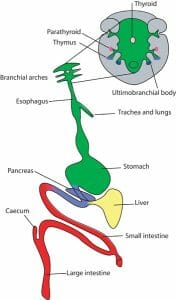Endoderm Definition
The endoderm is an embryonic germ layer that gives rise to tissues that form internal structures and organs. The endoderm is found in both vertebrate and invertebrate embryos, and is responsible for the formation of the gut and associated organs. Endoderm cells are present in both diploblasts and triploblasts.
Endoderm Formation
Germ layers form during gastrulation, although the cells are specified even earlier in development. The cells that will become the endoderm are found in the vegetal half of the egg, adjacent to the equatorial band. It has been suggested that future endoderm cell fate is predetermined by maternal factors in the egg.
It has been observed in mice that the primitive endoderm cells on the surface of the blastula that are adjacent to the blastocoel, the fluid filled cavity in the early blastocyst, will go on to develop into extra-embryonic membranes. These include both the parietal endoderm, which will form the Reichert’s membrane, and the visceral endoderm, a protective membrane surrounding the egg cylinder.
Although the endoderm will ultimately develop into internal structures, the future endoderm cells are initially located on the surface of the blastula. During the process of gastrulation the cells of the developing embryo drastically rearrange so that the germ layers end up in the correct positions. The endoderm migrates to the interior of the embryo as a sheet of cells in amphibians (known as involution) or as individual cells in birds and mammals (ingression).
Endoderm Function
The endoderm will become the digestive tract (or gut), as well as a number of associated organs and glands. It will give rise to the lungs, liver, and pancreas, as well as the thymus, thyroid, and parathyroid glands. In addition, endoderm cells will form the lining of many of the body’s organ systems including the respiratory system, the digestive system, the urinary system, and the reproductive system.
The gut is formed during gastrulation when the endoderm and mesoderm move inside the embryo in a process called invagination. As the cells move into the interior of the embryo the dorsal endoderm forms a line of cells along the mesoderm, and a gap forms between the dorsal endoderm and the vegetal endoderm cells. This gap is the archenteron which is the precursor of the gut cavity.

This figure depicts the organs and glands that develop from the endoderm. These include the digestive and respiratory systems, and the thyroid, parathyroid, and thymus glands.
Quiz
1. What structure is not formed by endoderm cells?
A. thymus gland
B. pituitary gland
C. thyroid gland
D. parathyroid gland
2. What structure will go on to form the gut?
A. archenteron
B. blastocoel
C. blastopore
D. yolk cells
3. Where are the primitive endoderm cells found?
A. animal region
B. equatorial band
C. marginal zone
D. vegetal region
References
- Campbell, N. A., & Reece, J. B. (2005).Biology, 7th. ed. Chs. 32 and 47. San Francisco, CA: Benjamin Cummings. ISBN: 0-8053-7171-0.
- Jessell, T., Lawrence, P., Meyerowitz, E., Robertson, E., & Smith, J. (2005).Principles of Development, 3rd. ed. Chs. 1, 3 and 7. New York, NY: Oxford University Press. ISBN: 0-19-927537-8.
Endoderm
No comments:
Post a Comment